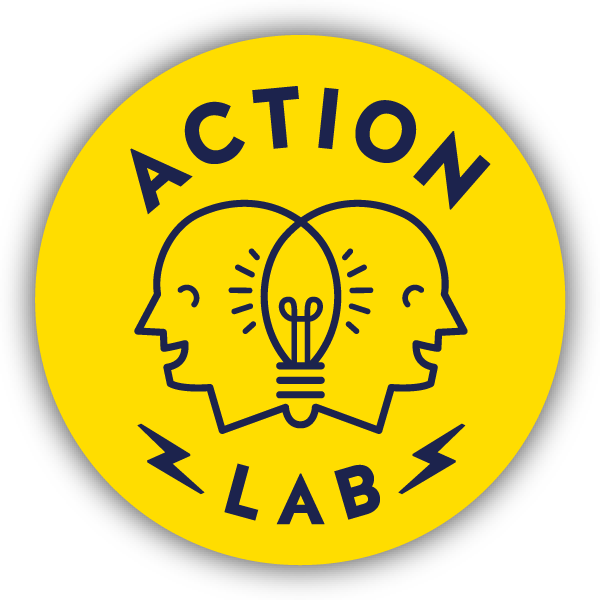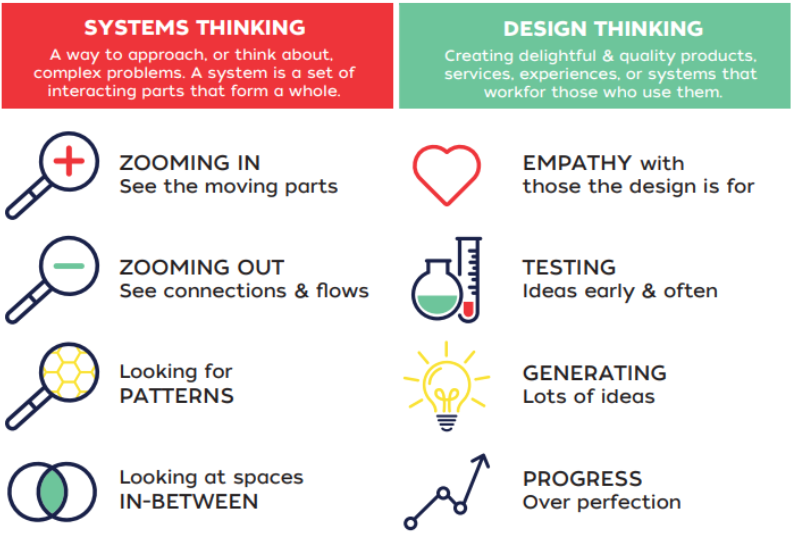What do we really mean when we say innovation and social innovation?
This is the first of a three part blog series by Action Lab Founder, Ben Weinlick. The first, this blog post, focuses on our definitions of innovation and social innovation. The second looks at the Innovation Swirl and explores what parts of a lab process we think should be focused on most. And the third blog explores some of the learning and unlearning we’ve been doing in the social innovation space to continuously improve our lab processes and make them more equitable and inclusive.
Link to Part 2: Should labs just generate good ideas or incubate and scale them too?
Link to Part 3: Learning and Unlearning in the Social Innovation Space Over the Years
_______________________________________
What do we mean by Innovation?
When we throw around the term innovation at Action Lab, we mean it is both about the processes of coming up with a relevant innovation and the relevant outcomes that emerge. We really like the following definition of innovation from long time Canadian Social Innovator Al Etmanski:
“Innovation is a mix of the old, the new and a dash of surprise”
In essence, Etmanski is saying that to find a relevant innovation we need to learn about the past - the history of what’s worked and not worked in a particular domain. We might need to de-construct past histories and pull through important learning and practices. Then we need to scan for promising new possibilities. Eventually there will be forms of mixing the old and new together in new combinations. What often emerges are unexpected insights, eureka moments, and surprises! When thoughtfully stewarded, all of that can lead to developing relevant innovations that matter.
What do we mean by Social Innovation?
With social innovation we also mean it’s about both the processes of finding solutions and outcomes that address complex, interconnected, social and environmental challenges. With social innovation, a key distinction is it aims to address root causes of challenges, not just produce band-aid solutions. Below are some definitions we like for the often harder to understand social innovation concept:
“A social innovation can be a product, process, or technology, but it can also be a principle, an idea, a piece of legislation, a social movement, an intervention, or some combination of them.”
– Stanford Social Innovation Review
“With Social Innovation, we believe the problem solving process should aim at not just creating more band aid solutions, but go deeper to tackle problems at their root. We see social innovation as being both about outcomes and processes. The outcomes of social innovation processes should be better solutions to complex problems facing our world. Better means social innovation solutions truly work better for people, communities, systems and the planet. Outcomes should also aim to have fewer negative side effects from proposed interventions. Social innovation really aims at helping as many as easily possible, rather than a solution just for a few in a system”
– Skills Society Action Lab
“Social innovation recognizes that a single individual is not the cause of complex challenges nor the only source of a promising intervention. In many ways, collective problem solving in Indigenous communities has been around for thousands of years, striving to meet all the challenges that might affect the community. Indigenous communities think and act in systems, and recognize the interconnectedness of land, water, people, the winged and four-legged ones.”
– Jodi Calahoo-Stonehouse, Co-founder and steward of the Edmonton Shift Lab
Social Innovation as a process
In essence, a social innovation process is a collaborative problem solving approach that helps a diverse collective make sense of root causes of a complex challenge and then generate possible solutions that can be stress tested with real world people and systems who are affected. These processes often mix together systems thinking, design methods, ethnography, behavior change theory, critical theories, participatory action research, and indigenous worldviews (where appropriate and guided by elders and knowledge keepers). Rather than just talk about an issue, a social innovation approach helps facilitate a diverse collective to make ideas tangible and testable. By testing proposed solutions before investing in pilots, it helps a collective surface assumptions that would have caused bigger problems if left unchecked.
Systemic Design?
Systems thinking vs design thinking diagram
Systemic design could be seen as a framework for sense making and problem solving that blends systems and design methods. Contrary to surface level assessments of systemic design, systemic design methods are not rigid in their approach, and are ever evolving. Within systemic design there are rich participatory co-creation activities that can help diverse collectives tackle complex challenges. Although at Action Lab we always tweak and adapt innovation processes to fit unique contexts, there are some common principles of integrating both systems thinking practices and design thinking methods. It’s important to note that there are many eastern, and indigenous systems thinking epistemologies that are completely valid and often appropriately integrated in collective problem solving processes. I say this because there is a common myth that systems thinking is solely a western idea when in fact thinking in interdependent systems has deep roots in for instance 2500 year old Buddhist traditions of the east and indigenous traditions of Treaty 6 territory and beyond in Canada. The chart here helps to illustrate why it’s helpful to have both systems and design approaches integrated in a good collective innovation process.
What is not Social Innovation?
Social Innovation and Social Entrepreneurship are often conflated as the same thing and we think that is a mistake. A social enterprise or social good business isn’t always aiming to address root causes of a complex challenge. For example, a thrift store social enterprise that generates revenue for a charity, could also have a mission to employ people with disabilities. That’s great, but not really working at a systemic level, with larger collectives, around inequities in employment and disability rights issues.
On the other hand, a social enterprise may have a mandate for systemic impact and so it might have the potential for social innovation. For example, we stewarded the creation of MyCompass Planning Inc, which aims to humanize social service case management and planning, so that the voices of people with disabilities served are not pushed to the sidelines in service delivery. The enterprise aspect of this venture helps to generate research and development dollars. As it scales and more organisations adopt MyCompass Planning, the aim is to keep re-designing the architecture and interactions of how social services are delivered - re-designing them so that organisations and systems instinctively centre rights and good relationship building between service providers and those served. In that way this social enterprise aims at systemic impact around the complex challenge of dehumanised case management and power imbalance in the delivery of social services.
We think you’re a social innovator if you…
Are working on tackling root causes of a complex social issue
Are not just tackling the issue as an individual but are working with diverse collectives around a complex issue to both understand and create new pathways forward
Are not just focused on programmatic intervention, but striving for systemic impact
Are weaving and remixing combinations of solution finding processes such as systems thinking, design thinking, behaviour change theory, ethnography, critical theories, and aspects of collective impact
What’s coming in Part 2
Now that I’ve clarified what (at present) we have learned from both the literature and practice on the ground related to definitions of innovation and social innovation, in part 2, I’ll explore innovation processes and what parts of the process we think are best focused on in most labs tackling complex challenges.
Link to Part 2: Should labs just generate good ideas or incubate and scale them too?
Want to learn more?
Think Jar Collective Social Innovation Lab Field Guide
Join our Edmonton based Systemic Design Exchange community of practice
Check out examples of our innovation and social innovation work in action
ABSI - Alberta Social Innovation Connect
References and Good Sources on Social Innovation
Think Jar Collective Social Innovation Lab Field Guide
McConnell Foundation 2018 12 lessons shared on Social Innovation
Social Labs - McConnell Foundation
Thanks for reading! Follow us on social media to see future posts @ActionLabYEG.



